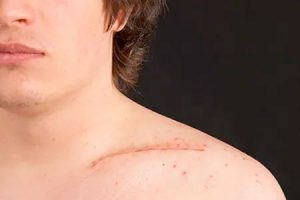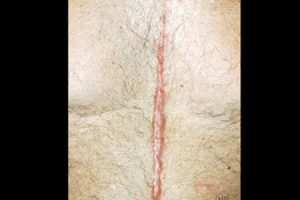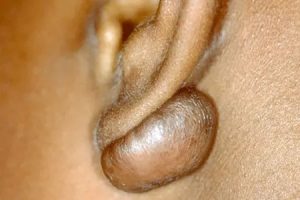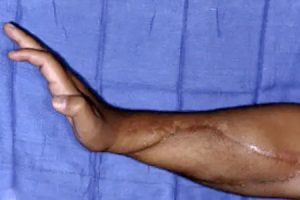Scars
Scars: Signs and symptoms
Scars come in many shapes and sizes. If you have two or more scars, you may notice that the two scars look very different. This happens because so much affects what a scar looks like, including the:
- Cause (accident, acne, burn, surgery, etc.)
- Wound (size and how deeply the wound penetrated your skin)
- Body part (where you wounded your skin)
- Wound care (how you treated the wound)
Your genes, age, skin color, and the medications you take can also affect how your skin heals.
Types of scars
When a scar forms on the skin, it will be one of the following types.

Flat scar – Most scars, such as the one on this man’s skin, are flat.
Flat scar
Medical name: Cicatrix
What it looks like: While you will eventually see a flat scar, when this scar first appears it tends to be pink to reddish in color and slightly raised. It may also be itchy or painful.
As your skin continues to heal, the scar will flatten and change color. In time, many flat scars are nearly the same color as your skin. A flat scar may also be paler or slightly darker than your surrounding skin.
Proper wound care may increase the likelihood that you’ll see a flat scar instead of a raised scar.

Raised scar – A raised scar appeared on this man’s chest after surgery.
Raised scar
Medical name: Hypertrophic scar
What it looks like: This scar rises above the surface of your skin, so you see a raised, firm scar.
Over time, raised scars tend to flatten, but flattening can take months or years. A raised scar is most likely to form on the chest, upper back, or shoulder area, but it can appear anywhere on your skin.
Some raised scars itch or feel painful. If the scar is large or forms on a shoulder, elbow, or other joint, it can restrict your movement. If you experience any of these problems, you should see a board-certified dermatologist. Treatment can relieve these complications.

Depressed scar – These deep scars, called icepick scars, appeared when severe acne cleared.
Depressed scar
Medical name: Atrophic scar
What it looks like: These scars sit below the surface of your skin, giving the skin a sunken or pitted look. Most depressed scars form on the face.
Sunken scars can become more noticeable as you age. This happens when the skin relaxes and sags, causing the depressions to become more noticeable.
You’re more likely to develop depressed scars after chickenpox or severe acne clears.
Depressed scars are so common after severe acne clears that dermatologists divide these acne scars into these three types:
- Boxcar acne scar
- Icepick acne scar
- Rolling acne scar
Separating acne scars into distinct types allows a dermatologist to treat each a bit differently, which gives patients the best results.

Keloid scar – The mass on this girl’s earlobe is a keloid, which appeared several months after she had her ears pierced.
Keloid
Medical name: Keloid
What it looks like: This scar rises above the surface of the skin. Unlike other raised scars, keloids grow much larger than the wound that caused the scar.
A keloid may appear months or even a year after you injure your skin.
As a keloid grows, it may feel painful or itchy. Like other raised scars, a keloid can reduce your ability to move if it forms over a joint, such as the shoulder or elbow, or grows very large. Treatment can help ease these complications.
While flat and raised scars may eventually become less noticeable, keloids never go away without treatment.

Contracture scar – After a blast injured this man’s arm, he developed this contracture scar, which limits his ability to move his wrist, forearm, and fingers.
Contracture scar
Medical name: Contracture scar
What it looks like: When a scar forms, the new tissue tends to be tighter and thicker than your skin. Sometimes, this tightening makes it difficult to move. Any scar that limits movement is called a contracture scar.
Burns, except for minor ones, often cause a contracture scar. A contracture scar on your knee may mean that you’ll no longer be able to fully straighten your leg.
Because a contracture scar can restrict movement, it is a serious complication.
You can also develop a contracture scar if a large keloid forms.

A burn can cause a contracture scar. If you have a serious burn, go to a burn center. Getting treatment at a burn center can help you prevent a contracture scar.

Stretch marks – Any time your skin expands quickly, such as during pregnancy, you can develop stretch marks.
Stretch marks
Medical name: Striae
What it looks like: Yes, stretch marks are a type of scar. Stretch marks are scars because they cause breaks in our connective tissue (the tissue that lies beneath our skin and gives it shape).
We typically get stretch marks when our skin grows or shrinks quickly, such as during pregnancy, rapid weight loss or gain, or adolescence. Bodybuilders and weight lifters who bulk up quickly can also develop stretch marks.
Early stretch marks are often red, purple, or dark brown. As stretch marks mature, they lighten and tend to look white or silver. Stretch marks can be slightly raised or sit a bit lower than the surface of your skin.
Images
Images 1, 6: Getty Images
Images 2,3,4,7: Used with permission of the American Academy of Dermatology National Library of Dermatologic Teaching Slides.
Image 5: Used with permission of the Journal of the American Academy of Dermatology. J Am Acad Dermatol. 2014;71:841-2.
Reference:
Gold MH, McGuire M, et al. “Updated international clinical recommendations on scar management: Part 2—Algorithms for scar prevention and treatment.” Dermatol Surg. 2014;40(8):825-31.
© 2025 American Academy of Dermatology. All rights reserved. Reproduction or republication strictly prohibited without prior written permission. Use of these materials is subject to the legal notice and terms of use located at https://www.aad.org/about/legal
